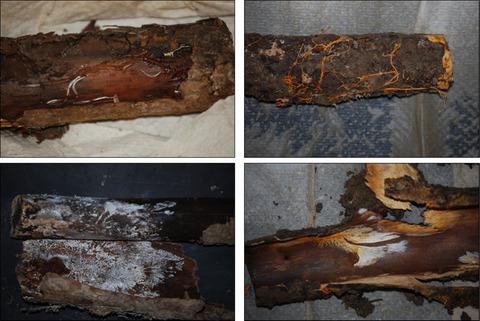Our official English website, www.x-mol.net, welcomes your feedback! (Note: you will need to create a separate account there.)
Feedbacks between forest structure and an opportunistic fungal pathogen
Journal of Ecology ( IF 5.5 ) Pub Date : 2021-09-18 , DOI: 10.1111/1365-2745.13780 Christopher A. Lee 1 , Ricardo M. Holdo 2 , Rose‐Marie Muzika 3
中文翻译:

森林结构与机会性真菌病原体之间的反馈
更新日期:2021-09-18
Journal of Ecology ( IF 5.5 ) Pub Date : 2021-09-18 , DOI: 10.1111/1365-2745.13780 Christopher A. Lee 1 , Ricardo M. Holdo 2 , Rose‐Marie Muzika 3
Affiliation

|
- Abiotic stresses, physiological dysfunction, forest stand dynamics and primary tree attackers (native and non-native) are all recognized as important contributors to both anomalous tree mortality and background tree mortality, and thus as important influences on biogeochemical cycling and habitat for associated terrestrial organisms. Opportunistic and latent tree pathogens and insect pests have largely been left out of this discussion, probably because they are difficult to monitor and their effects sometimes more diffuse, yet they play important roles in tree mortality scenarios.
- We know very little about the influence of biotic gradients, for example, forest dynamics and forest structure, on the occurrence and effects of these opportunistic biotic enemies. To better understand the influence of an important biotic gradient—forest structure as represented by tree density and competition—on the occurrence and distribution of a typical opportunistic pathogen, we analysed the relationship between tree neighbourhood competition and soil-dwelling rhizomorphs of the fungus Armillaria gallica in regenerating (20-year-old) and mature (80- to 100-year-old) hardwood-dominated forest stands in central Missouri following a severe drought.
- We detected A. gallica rhizomorphs in twice as many sampling sites in young (dense) plots as in mature (open) plots, and by contrast found a twofold occurrence of other saprophytic fungi in the soil of mature plots compared to young plots. Mean tree density and competition index were significantly higher in subplots where A. gallica was found than in those with no A. gallica detections, and the pattern of A. gallica occurrence tracked closely with the occurrence of dense ‘hotspots’ of competition in the plots.
- Synthesis. Early stages of forest structure and succession—potentially through initial inputs of disturbance-produced woody biomass, increased host connectivity and competition-influenced host tree susceptibility to fungal colonization—provide important feedbacks to A. gallica foraging, which in turn influences forest development. The recognition that tree density and competition influence A. gallica foraging suggests that, to achieve a more comprehensive understanding of forest growth, development, tree mortality and biogeochemical cycling, it may be necessary to increase life-history studies and basic occurrence surveys for opportunistic tree pathogens and insect pests.
中文翻译:

森林结构与机会性真菌病原体之间的反馈
- 非生物胁迫、生理功能障碍、林分动态和主要树木攻击者(本地和非本地)都被认为是导致异常树木死亡和背景树木死亡的重要因素,因此也是对相关陆地生物的生物地球化学循环和栖息地的重要影响. 机会主义和潜伏的树木病原体和害虫在很大程度上被排除在讨论之外,可能是因为它们难以监测,而且它们的影响有时更加分散,但它们在树木死亡场景中发挥着重要作用。
- 我们对生物梯度的影响知之甚少,例如森林动态和森林结构,对这些机会性生物敌人的发生和影响的影响。为了更好地了解一个重要的生物梯度——以树木密度和竞争为代表的森林结构——对典型机会性病原体的发生和分布的影响,我们分析了树木邻域竞争与真菌蜜环菌的土生根状茎之间的关系在严重干旱后,密苏里州中部的再生(20 岁)和成熟(80 至 100 岁)硬木占主导地位的林分。
- 我们在年轻(密集)地块的采样点数量是成熟(开放)地块的两倍,我们检测到A. Gallica根状菌,相比之下,与年轻地块相比,成熟地块的土壤中其他腐生真菌的发生率增加了两倍。平均树的密度和竞争指数都在次要情节显著较高A.高卢发现比那些没有A.高卢检测和格局A.高卢发生密集的出现在地块竞争的“热点”紧密跟踪.
- 合成。森林结构和演替的早期阶段——可能是通过干扰产生的木质生物量的初始输入、宿主连通性的增加和竞争影响的宿主树对真菌定殖的敏感性——为A. Gallica觅食提供了重要的反馈,这反过来又影响了森林的发展。树木密度和竞争影响A. Gallica觅食的认识表明,为了更全面地了解森林的生长、发育、树木死亡和生物地球化学循环,可能有必要增加机会性树木的生活史研究和基础发生调查。病原体和害虫。



























 京公网安备 11010802027423号
京公网安备 11010802027423号